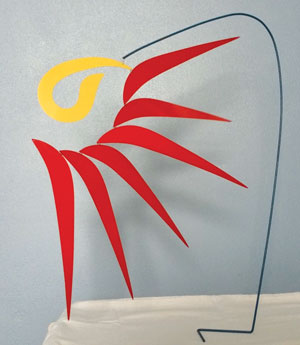Kinetic art balances physics, fantasy
 Balance. Motion. Energy. Wonder.
Balance. Motion. Energy. Wonder.
These are the captivating elements of Dean Flaig’s dynamic mobiles and their stationary counterparts, stabiles. Flaig’s pieces range from abstract forms that utilize color and shape to figures that reference nature, wildlife and objects like sailboats.
What most people don’t realize is the physics and engineering that go into creating a true mobile. A mobile, by definition, is suspended by one point, and the rest of the piece takes shape from that single point.
“You may look at it and have no wonderment at all,” says Flaig, “but when you start to see that it’s one piece hanging there and it takes a whole different shape from there, it seems to defy gravity … it’s a brain teaser for a lot of people.”
 A sales engineer by trade, Flaig first became interested in kinetic art when he saw the work of American sculptor Alexander Calder, who is known as the originator of the mobile and stabile. While Calder’s influence got Flaig started, the Menasha resident has broadened his scope and developed many of his own original designs.
A sales engineer by trade, Flaig first became interested in kinetic art when he saw the work of American sculptor Alexander Calder, who is known as the originator of the mobile and stabile. While Calder’s influence got Flaig started, the Menasha resident has broadened his scope and developed many of his own original designs.
“It keeps coming back to me in my meditation, these possibilities, these forms that I’ve never seen before, but I feel like I can accomplish,” says Flaig. “The physics part of it, the balancing and shaping of not only just the piece parts, but the form that they take when they’re assembled together, that’s what drew me to this form. The medium was readily available, inexpensive … so it wasn’t like I was spending a lot of money to do experimentations.”
Using mostly sheet aluminum, wire and stainless steel, Flaig designs shapes and patterns, cuts them out or bends his materials by hand, drills holes, attaches wires and hooks, welds and puts together his pieces with a meticulousness that requires both patience and attention to detail.
“With the computer capabilities now, I’m doing everything with a copy machine,” explains Flaig. “I can draw forms, take things out of my brain and rough-sketch them, and computers can just dial it all in, get all the lines nice and smooth and contoured by hitting a button. The technology today is just working in my favor here.”
With his background in mechanical and hydraulic engineering components, Flaig hopes to turn his smaller pieces — which he thinks of as prototypes — into something of a much larger scale, ideal for lobbies and other large spaces.
“I have enough tools here than I can jump right into it and just do more experimentation right now, and if I find something that I really like, I know the sources of who can make these things with water jetting,” says Flaig. “With the manufacturing that’s part of my career, the technology there could burn sheets of these parts for me in a matter of minutes, instead of me getting down there with a sanding wheel and trying to form all these individual parts and everything.”
Flaig’s vision may be large-scale, but his prototypes are impressive works of art in their own regard. “Everybody that has seen them — and that’s not many people, because I haven’t really gone out and showed them — comes in the house and sees them and goes, ‘Oh, wow!’” says Flaig, who has given away pieces to family and also sold a few to interested individuals. “That’s the only exposure that I’ve had to anybody seeing what I’ve done. Maybe this is something that will be my retirement escape. … I’m at the stage in my life, with a few years left in my career, that I can start putting the pieces together and get this out there.”
Flaig is looking to create an artist website in the near future, and in the meantime is willing to discuss special projects or pieces similar to those he has already created. Interested buyers can reach Flaig by email at [email protected] or by calling (319) 830-0947.










Leave a Comment